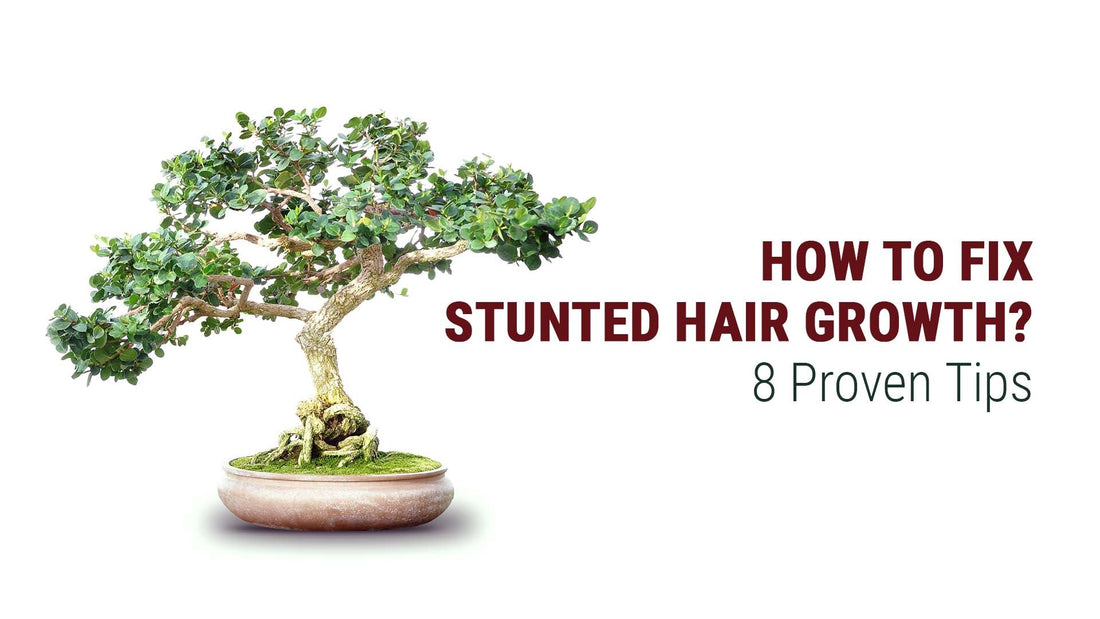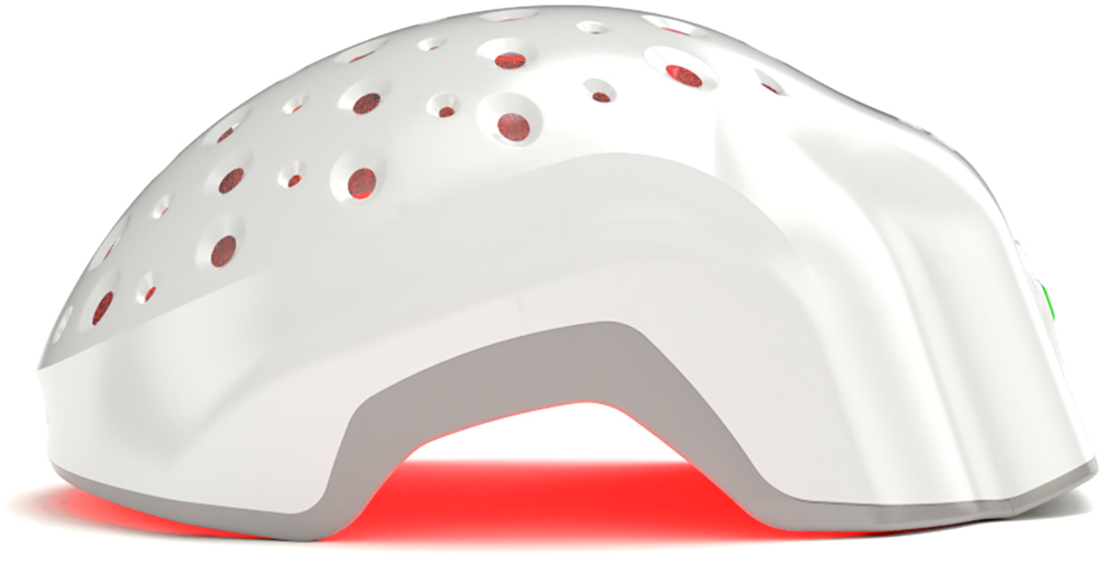Noticing that your hair just isn’t growing like it used to? Stunted hair growth or hair stagnation is a common problem that can leave your strands looking thin, uneven, and unhealthy, no matter how well you care for it. Whether it’s due to breakage, a poor hair care routine, scalp issues, or even stress and nutritional deficiencies, slow or stagnant hair growth can be frustrating.
In this blog, we’ll break down the most common causes of stunted hair growth and show you science-backed ways to fix it. From improving your scalp health and using the right hair products to nourishing your body with essential nutrients, you’ll discover simple strategies to fix stunted hair growth and get healthy hair.
Understanding the Hair Growth Cycle
To fix stunted hair growth, it’s important to first understand how the hair growth cycle works. Hair doesn’t grow continuously; it goes through a natural cycle made up of four main phases:
- Anagen (Growth Phase): This is the active phase where hair grows from the root. It can last from 2 to 7 years, depending on genetics and overall health. Most of your hair (about 85-90%) is in this phase.
- Catagen (Transition Phase): A short phase (2-3 weeks) where hair growth slows and the follicle begins to shrink.
- Telogen (Resting Phase): During this 3-month phase, the hair doesn’t grow but stays in place. Around 10-15% of your hair is in this phase at any time.
- Exogen (Shedding Phase): This is when the old hair falls out, making room for new hair to grow.
If your hair is stuck in the telogen or catagen phase for too long or if it exits the growth phase prematurely, you may notice slowed or stunted hair growth. Factors like stress, poor nutrition, scalp inflammation, or underlying health conditions can disrupt this cycle.
What Causes Stunted Hair Growth?
Hair doesn’t stop growing for no reason. When growth slows down or seems stuck, it's usually because something is disrupting your natural hair growth cycle. Stunted hair growth happens when hair follicles don’t function properly, meaning they’re not producing strong, healthy strands like they should.
Here are the most common causes why your hair might stop growing:
- Genetics: Your genes can influence how your hair grows and how it stops. If hair thinning or pattern baldness runs in your family, you may also inherit it. Likewise, genetics can influence your sensitivity to DHT (dihydrotestosterone), a hormone that shrinks hair follicles and shortens the growth phase. This can lead to slower growth, finer strands, and stunted hair over time.
- Age: Research shows that your hair growth naturally slows down as you get older. Hair follicles shrink and spend less time in the growth phase, leading to thinner, shorter strands. Hormonal changes, especially after menopause or around age 50, can also cause noticeable hair thinning and stunted growth in both men and women. According to the American Hair Loss Association, 85% of males will have significantly thinner hair by the age of 50.
- Hormonal Imbalances: Hormonal imbalances can affect hair growth in both men and women. Hormones like dihydrotestosterone (DHT), cortisol, and thyroid hormones can interfere with hair follicle function. DHT, a byproduct of testosterone, can shrink hair follicles in individuals predisposed to hair loss. Meanwhile, thyroid imbalances can disrupt the anagen (growth) phase of the hair cycle, slowing overall hair production.
- Stress: Chronic stress can significantly contribute to stunted hair growth. A stressful event, illness, or prolonged anxiety can trigger your hair to stop growing and start shedding, leading to stress-induced hair loss or telogen effluvium. Stress also triggers cortisol production, which indirectly affects hair growth by reducing blood flow and nutrient delivery to the scalp.
- Nutritional Deficiency: Your hair needs specific nutrients like iron, zinc, biotin, and protein for healthy growth. Scientific studies have shown that iron deficiency is a common cause of stunted hair growth, especially among women. Similarly, a lack of biotin or zinc can lead to brittle hair that breaks before it grows to its full potential.
- Health Conditions: Medical conditions like alopecia areata, polycystic ovary syndrome (PCOS), and thyroid disorders often come with the side effect of slowed or halted hair growth. Alopecia areata is an autoimmune disorder where the body mistakenly attacks its own hair follicles. PCOS throws hormones out of balance, leading to an overproduction of DHT, while hypothyroidism slows down all growth processes, including your hair.
- Environmental Factors: Environmental factors like pollution, UV exposure, and weather can sap moisture and weaken your hair shafts. Pollutants can block your hair follicles and slow down growth. Similarly, UV rays can degrade hair proteins, leaving strands brittle and prone to breakage. Harsh weather, like wind or extreme dryness, also dehydrates your hair and hinders new growth.
What Are the Signs of Stunted Hair Growth?
Here are the common signs of stunted hair growth:
- Slow Hair Growth: One of the clearest signs of stunted hair growth is when your hair takes much longer to grow than usual. You may notice that your hair no longer reaches the same length it once did or that progress is painfully slow over several months, especially as you age or go through hormonal changes.
- Hair Thinning: Noticeably thinner strands or less overall volume is another sign of stunted hair growth. It could mean your follicles are struggling to stay in the growth phase.
- Hair Breakage: If your hair keeps snapping off before it gets longer, breakage could be covering real growth. Weak, brittle strands often break mid-shaft or at the ends, making it seem like your hair isn’t growing, even if it actually is at the root. This can be a major sign of stunted length retention.
8 Easy Tips to Fix Stunted Hair Growth
Here are the 8 easy and proven ways to fix your stunted hair:

1. Maintain a Healthy Diet
Nutrients play a big role in how your hair grows. A lack of key nutrients like iron, omega-3s, and protein can slow growth and weaken strands. Eating a balanced diet with these essentials helps nourish your hair follicles from within. Biotin can support overall hair health, but it works best as part of a nutrient-rich diet, not on its own.
2. Stay Hydrated
Dehydration not only affects your skin and energy levels but also your hair’s growth rate. When your scalp is dehydrated, hair follicles struggle to function, leading to slower growth. Keep those roots healthy by drinking enough water daily. After all, hydrated follicles are productive follicles.
3. Use the Right Hair Products
Using the wrong products or ones packed with harsh sulfates and alcohols can strip off your hair's natural oil and can damage your scalp and strands. Opt for products tailored to your hair type, and look for strengthening ingredients like keratin and peptides. Incorporating hair growth oils like argan or rosemary oil can also provide added nourishment and improve follicular health. Clean, well-nourished hair is more likely to grow healthy.
4. Regular Scalp Care
Regular scalp care, including cleansing, exfoliation, and moisturization, ensures that your follicles aren’t clogged with excess oil, dirt, or product buildup and creates a heathy scalp environment. It also boosts blood flow to the scalp, delivering nutrients to where they’re needed most. Ingredients like tea tree oil or gentle scalp scrubs can help you maintain a clean, balanced foundation for growth.
5. Avoid Excessive Heat and Chemical Treatments
Overexposure to heat tools and harsh chemicals weakens the hair shaft, leading to breakage and stunted growth. Minimize the use of these treatments, and always use heat protectants when styling. Limiting these stressors helps your strands stay strong and grow uninterrupted.
6. Reduce Stress
Stress can significantly impact hair growth. To help your hair grow, focus on simple ways to reduce stress daily. Activities like spending 15 minutes outdoors, practicing deep breathing, or even dancing can help. Your hair grows best when you're relaxed, so finding small ways to chill out each day isn't just self-care; it's essential for your hair's health.
7. Trim Your Hair Regularly
Cutting your hair actually helps it grow better. Regular trims don't magically speed up growth from your roots, but they prevent split ends from traveling up the hair shaft and breaking off more length than you're gaining. When you skip trims for months, those splits climb higher and cause breakage that makes your hair look shorter and thinner. Getting a trim every 6-8 weeks removes the damaged ends before they can sabotage your progress.
8. Massage Scalp Regularly
Regular scalp massages can increase blood flow to the scalp and encourage hair growth. For further benefits, you can use hair serums during massage.
Conclusion
Stunted hair growth doesn’t have to be a permanent problem. From cleaning up your diet to rethinking your hair care routine, these easy fixes can revive sluggish strands and get them growing again. Focus on what your hair needs, stay consistent, and remember—healthy habits lead to healthy hair.
If you want to regrow your hair and lifestyle changes aren't enough, you can check out laser therapy devices like Theradome Laser Helmet. These clinically tested devices use low-level lasers to stimulate hair follicles, though results vary from person to person and typically require consistent use over several months.






















